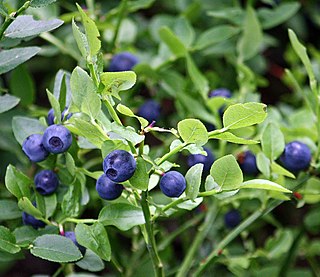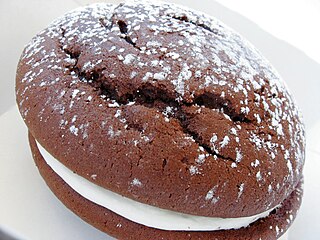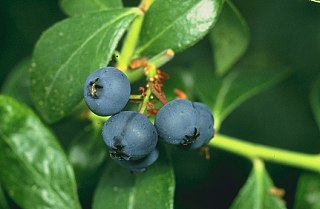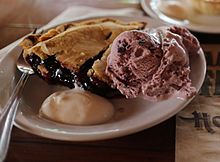
New England cuisine is an American cuisine which originated in the New England region of the United States, and traces its roots to traditional English cuisine and Native American cuisine of the Abenaki, Narragansett, Niantic, Wabanaki, Wampanoag, and other native peoples. It also includes influences from Irish, French, Italian, and Portuguese cuisine, among others. It is characterized by extensive use of potatoes, beans, dairy products and seafood, resulting from its historical reliance on its seaports and fishing industry. Corn, the major crop historically grown by Native American tribes in New England, continues to be grown in all New England states, primarily as sweet corn although flint corn is grown as well. It is traditionally used in hasty puddings, cornbreads and corn chowders.

A berry is a small, pulpy, and often edible fruit. Typically, berries are juicy, rounded, brightly colored, sweet, sour or tart, and do not have a stone or pit, although many pips or seeds may be present. Common examples of berries in the culinary sense are strawberries, raspberries, blueberries, blackberries, red currants, white currants and blackcurrants. In Britain, soft fruit is a horticultural term for such fruits.

A pie is a baked dish which is usually made of a pastry dough casing that contains a filling of various sweet or savoury ingredients. Sweet pies may be filled with fruit, nuts, fruit preserves, brown sugar, sweetened vegetables, or with thicker fillings based on eggs and dairy. Savoury pies may be filled with meat, eggs and cheese or a mixture of meat and vegetables.

Shepherd's pie, cottage pie, or in its French version hachis Parmentier, is a savoury dish of cooked minced meat topped with mashed potato and baked, formerly also called Sanders or Saunders. The meat used may be either previously cooked or freshly minced. The usual meats are beef or lamb. The two English terms have been used interchangeably since they came into use in the late 18th and early 19th centuries, although some writers insist that a shepherd's pie should contain lamb or mutton, and a cottage pie, beef.

Bilberries or blueberries are primarily Eurasian low-growing shrubs in the genus Vaccinium, bearing edible, dark blue berries. The species most often referred to is Vaccinium myrtillus L., but there are several other closely related species.

A crumble is typically a dessert with a crumbly topping consisting of flour, butter, sugar, and sometimes oats, baked over a fruit filling. Apple and rhubarb are two popular varieties. Savoury fillings such as meat, cheese or vegetables may alternatively be used. As a dessert, crumbles are traditionally served with custard, cream, or ice cream.

Pierogi or pierogies are filled dumplings, made by wrapping unleavened dough around a filling, and occasionally flavored with a savory or sweet garnish, finally cooked in boiling water.

Cheesecake is a dessert made with a soft fresh cheese, eggs, and sugar. It may have a crust or base made from crushed cookies, graham crackers, pastry, or sometimes sponge cake. Cheesecake may be baked or unbaked, and is usually refrigerated.

Amelanchier alnifolia, the saskatoon berry, Pacific serviceberry, western serviceberry, western shadbush, or western juneberry, is a shrub native to North America. It is a member of the rose family, and bears an edible berry-like fruit.

Shortcake generally refers to a dessert with a crumbly scone-like texture. There are multiple variations of shortcake, most of which are served with fruit and cream. One of the most popular is strawberry shortcake, which is typically served with whipped cream. Other variations common in the UK are blackberry and clotted cream shortcake and lemon berry shortcake, which is served with lemon curd in place of cream.

Steak and kidney pie is a popular British dish. It is a savoury pie filled principally with a mixture of diced beef, diced kidney and onion. Its contents are generally similar to those of steak and kidney puddings.

Canadian cuisine consists of the cooking traditions and practices of Canada, with regional variances around the country. First Nations and Inuit have practiced their culinary traditions in what is now Canada since at least 15,000 years ago. The advent of European explorers and settlers, first on the east coast and then throughout the wider territories of New France, British North America and Canada, saw the melding of foreign recipes, cooking techniques, and ingredients with indigenous flora and fauna. Modern Canadian cuisine has maintained this dedication to local ingredients and terroir, as exemplified in the naming of specific ingredients based on their locale, such as Malpeque oysters or Alberta beef. Accordingly, Canadian cuisine privileges the quality of ingredients and regionality, and may be broadly defined as a national tradition of "creole" culinary practices, based on the complex multicultural and geographically diverse nature of both historical and contemporary Canadian society.

The Nanaimo bar is a bar dessert that requires no baking and is named after the Canadian city of Nanaimo in British Columbia. It consists of three layers: a wafer, nut, and coconut crumb base; custard icing in the middle; and a layer of chocolate ganache on top. Many varieties exist, consisting of various types of crumb, various flavours of icing, and various types of chocolate.

The whoopie pie, alternatively called a black moon, gob, black-and-white, bob, or BFO, is an American baked confection that may be considered either a cookie, pie, sandwich, or cake. It is made of two round mound-shaped pieces of usually chocolate cake, or sometimes pumpkin, gingerbread or other flavored cakes, with a sweet, creamy filling or frosting sandwiched between them.

Blueberry pie is a pie with a blueberry filling. Blueberry pie is readily made because it does not require pitting or peeling of fruit. It usually has a top and bottom crust. The top crust can be circular, but the pie can also have a crumble crust or no top crust. Blueberry pies are often eaten in the summertime when blueberries are in season in the Northern hemisphere.

Blueberry is a widely distributed and widespread group of perennial flowering plant with blue or purple berries. They are classified in the section Cyanococcus within the genus Vaccinium. Vaccinium also includes cranberries, bilberries, huckleberries and Madeira blueberries. Commercial blueberries—both wild (lowbush) and cultivated (highbush)—are all native to North America. The highbush varieties were introduced into Europe during the 1930s.

The Maritimes consist of the provinces of New Brunswick, Nova Scotia and Prince Edward Island. Some of the cuisine has its origins in the foods of the indigenous peoples of the region.

Bumbleberry pie is a Canadian mixed berry pie originating from the Maritimes. It is made of at least three kinds of berries, but generally refers to a mixed berry pie, as there is no such berry as a "bumbleberry". This pie often also contains apple and/or rhubarb. Berries commonly used in this pie may include blueberries, raspberries, strawberries, and blackberries.

Blueberry sauce is a sauce prepared using blueberries as a primary ingredient. It is typically prepared as a reduction, and can be used as a dessert sauce or savory sauce depending on the preparation. It can also be used in the preparation of the blueberry Martini.
Pie in American cuisine has roots in English cuisine and has evolved over centuries to adapt to American cultural tastes and ingredients. The creation of flaky pie crust shortened with lard is credited to American innovation.


















